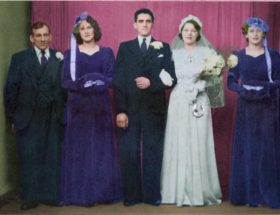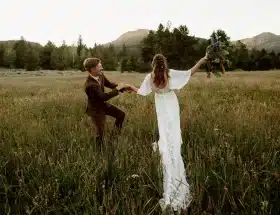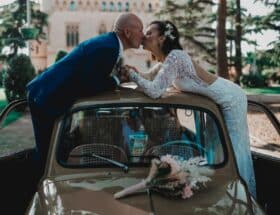By Pauline Weston Thomas for Fashion-Era.com
- A Modern Wedding for Paul and Wendy in 1999
- A Red Wedding Dress
- Bindi and Mehndi
- A 1994 Marriage Act Change in Licensed Properties for Wedding Venues
- Wedding Expenses
- General Registrars
A Modern Wedding for Paul and Wendy in 1999
Paul and Wendy were married at Cambridge in 1999. Paul is the son of regular website visitor Vera married in 1961.
Paul and Wendy decided they wanted a wedding with elements of both the traditional and the modern.
They were very much inspired by a joint visit to India that they had taken before they married. Paul and Wendy became engaged whilst travelling hippie-like in India.
The wedding itself was a civil wedding service held at Stow-Cum-Quy, Cambridge, England.
As you can see, the photographs were taken against weeping willows. At their wedding, Paul and Wendy chose to add hippy-inspired elements to their fairly formal wedding dress along with colorful flowers.
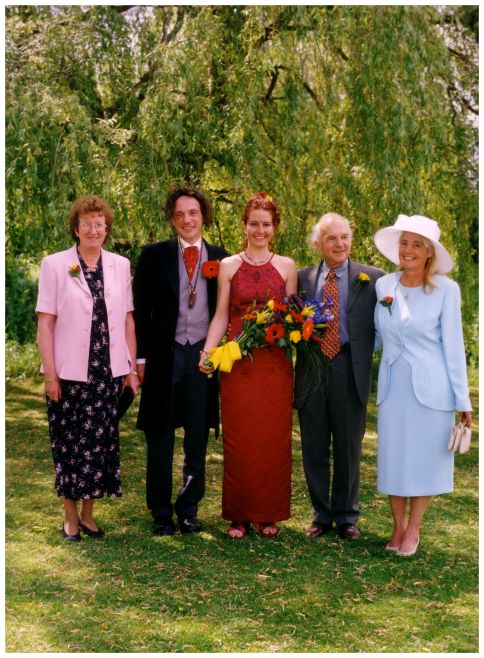
As the 1990s progressed many younger brides selected tied flowers over formal bridal sprays. Formal bridal sprays gained new popularity in the 1960s.
Sometimes modern bridal flowers were tied in a natural way with raffia strands or bound with long exotic shiny leaves. At other times colourful ribbons added character. Wendy chose dramatic colours to enhance her dress, a very different look to white roses, pastel orchids or arum lilies.
Wendy chose a red wedding gown and completed the modern approach with a Bindi on her forehead, but did not have her hands done Mehndi style with henna.
1999 Red Wedding Dress
In 1999, as the millennium beckoned the last decade of the century saw not only a change in wedding pattern styles, but also a fashion trend for adding more and more colour to the bride's wedding dress.
Wendy's red wedding dress is a statement of her modern approach. It illustrates her confidence to go against tradition at a time (1999), when coloured dresses were still only worn by a few western brides in UK. Despite this many other nationalities consider that the best colour to marry in is red. Brides in both India and China like to marry in red.
White wedding dresses have been worn in Britain since Queen Victoria a young virginal bride married in white. Until then and even after, many brides simply bought a quality dress in a neutral colour such as creamy beige so that they could wear the dress again and again. Others picked materials like silver lame which could enable a dress to be restyled into an evening gown. Often a woman would have two bodices made - one which was demure in cut for the wedding ceremony and one for future evening wear.
However in the fifty years post world War II as society became more affluent and modern fabrics brought affordable white gowns, brides mostly opted for a white wedding.
Now in the mid noughties decade, a coloured wedding dress is a very popular choice for many brides, with red wedding dresses being hot sellers.
Bindi, Mehndi & Henna
Women in India have decorated their faces for centuries with a Bindi dot, a mark placed between the two eyes, thus creating a third eye - the spiritual eye.
The red Bindi is usually regarded as a sign that a person belongs to the Hindu religion. The Bindi is also a reminder symbol of wedding vows. Married Hindu women wear it to symbolize their marriage. But many people now apply Bindi as a fashion accessory, a decoration considered to enhance beauty.
For over 5,000 years henna has been used as a cosmetic and colouring. The Pharaohs had their fingers stained Mehndi style before they were mummified. Henna grows in the soaring heat of countries like India, Pakistan, Egypt, North Africa and other East Asian places.
All of the henna plant that is above ground is harvested and the whole is ground into a fine powder which can be mixed with hot water to a thick paste. By adding a range of plant products like indigo or clove other colours can be created.
Mehndi
Mehndi originated in North Africa and the Middle Eastern countries during ancient times. One of the earliest documentations of henna use comes from ancient Egypt, where it is known to have been used to stain the fingers and toes of the Pharaohs prior to mummification. In other nations different Mehndi patterns are used.
African Mehndi art favours geometric forms, but in India, the Mehndi patterns are lace like and generally organic forms like paisley or floral patterns that cover the whole hand.
As more people marry between races, Mehndi evenings sometimes replace over zealous hen parties. Compared to the use of tattoos, Mehndi is a pain free form of decoration which lasts days rather than forever. Many celebrities such as Gwen Stefani, Demi Moore and Madonna have all been seen wearing Mehndi. Modern henna based Mehndi stencil products mean that even those with a Mehndi heritage can enjoy this art.
Wedding Verse
At the wedding Paul's father Peter read a poem he had composed for his speech. In a way the poem is probably a reflection of Peter's long term love for his own wife Vera and you can see their wedding here in the 1961 wedding photo page.

This wedding picture of Paul and Wendy is a formal keepsake, yet seems relaxed and is a long way from some of the stiffer posed pictures of even 50 years ago.
This is because weddings now also take place in much more relaxed settings such as hotels rather than religious buildings. The backdrop is more likely to be a lush garden rather than gravestones.
A Change in Licensed Property law for Wedding Venues 1994
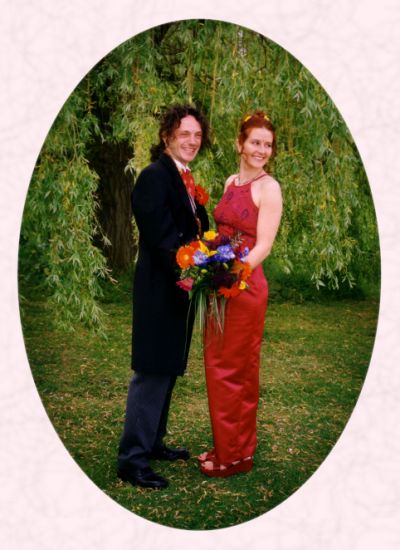
As Britain became more affluent, more secular, and more divorced couples wanted a second wedding, it became clear that a more modern approach to the wedding ceremony was required. The Register Office of old was not the attractive venue world-traveled couples expected to agree to their nuptial promises.
For some years Britain had been losing leisure economy revenue from the wedding market as couples began to go abroad to have weddings at exotic destinations.
Abroad the bride could marry in more relaxed, but still, special clothing and have unusual romantic touches, not suitable in a church or registry office setting.
Something was needed to help keep more of the wedding revenue in the UK whilst addressing the needs of a changing society with couples marrying not just the second time around, but sometimes three or four times.
So in 1994, the wedding licence property laws in the United Kingdom changed. The new 1994 Marriage Act allowed any building in England or Wales to apply to be registered as a licensed property for wedding ceremonies.
Many properties especially castles with landscaped grounds, racecourses, luxury country hotels and zoos applied to become a licensed venues. Now there are 3000+ of these venues. Historic Houses are especially popular as they make photographic backgrounds of splendour.
According to the Office for National Statistics
'Since 1992, there have been more civil marriage ceremonies in England and Wales than religious ceremonies. In 2004, 68 percent of marriages were solemnized by civil ceremonies. The Marriage Act 1994 provided for civil marriages to take place in approved premises from 1 April 1995. In 2004, 31 per cent of all marriages in England and Wales took place in approved premises, compared with 5 per cent in 1996.'
1999 Wedding Expenses
Marrying outside of a church or the local registry office is not the cheapest option.
In fact, costs are likely to be higher as extra fees are demanded since the registrar will have to travel to an out of town venue such as a remote country hotel. Despite reading that ordinary people frequently spend £20,000 on a wedding, you can actually get married in UK for very little - the cheapest fees are likely to be approximately £100 for a registered office ceremony or about £300 for the alternative Church fees ceremony.
But of course very few people dash along to the register office or church as if it was an ordinary day. Without some other expenditure that marks the day as special, as an event of note, most couples do not simply go through the motions of a ceremony to get the certificate proof of marriage. It is indeed a special day and for many people their wedding day is one of the happiest days of their life.
The whole point of a wedding is the word ceremony - which highlights the participant's involvement in making vows and promises for an adventure together, hopefully for a life partnership. The whole concept of marriage is imbued with optimism, selflessness, compromise, comfort, and hope for building a future of happiness by sharing joint adventures and ideas.
So as this concept must be celebrated, so then the costs start to add on as the dressing up, eating, drinking, partying and recording of the event are all are added to the accounts.
You can find plenty of wedding websites that cover wedding preparation information. My best advice is to stick closely to your budget and don't be too swayed by glossy magazines and websites that suggest you must have everything everyone else has. By all means, read the advice, but filter out what is frankly often unnecessary expenditure.
Do you really need the caterers to the stars to make your wedding cake at £1000+? Be realistic, will it really make that much difference and make you happier in the greater scheme of things if the person who made and decorated the cake for Posh, Madonna or Prince Charles can make your cake.
The more interesting venues accommodate those who want somewhere special for their big day, but find that a church wedding is meaningless to them. There are others who would like the special feel of a church wedding compared to a registry office, but realise that the third time round a church or chapel wedding might seem hypocritical.
Now those who want a more glamorous alternative to a civil registry office wedding can choose to have a formal wedding, but in surroundings more special than a Registry office at the back of the town. Now in UK it is possible to have the wedding ceremony and the wedding reception in one attractive building and one where guests often gather for one or two overnight stays.
With the exception of Quaker and Jewish ceremonies, in England and Wales it is only possible to get married in daylight hours between 8 am and 6pm. This is because an 'ancient' law states that there must be enough daylight for a man and woman to see the person they are about to marry. If a couple choose to marry in a civil ceremony in a Register Office then the hours are even more reduced to between 10am and 4pm in the week and to midday on Saturday. This means that in the UK it is more customary to marry by lunchtime and have a wedding reception in the afternoon.
In many cases a second reception is held with evening entertainment varying from a disco to a barn dance.
As the new laws for venue license properties came into effect so more and more people have begun to opt for a ceremony after 3 pm so the wedding can take them into an early evening affair. One of the first royal weddings to do this was that of Sophie Rhys Jones and H.R.H Prince Edward. They married after 5 pm at the last possible hour of the day. Guests were told not to wear hats. Most guests chose to wear evening dress for what was technically an evening function. As the new century approached new rules were emerging in weddings in England and Wales.
General Registrars
For further information on the requirements of individuals to marry in the British Isles contact:-
- Registrar General for England and Wales - 01704 569824
- Superintendent Registrar, Cardiff, Wales - 02920 871680
- General Register Office for Scotland - 0131 314 4447
- General Register Office for Northern Ireland - 028 9025 2000
- Superintendent Registrar for Jersey - 01534 502335
- Registrar General for Guernsey - 01481 725277
- General Register Office for the Isle of Man - 01624 687039
Page Added 22 October 2006 These wedding photos must not be published or used elsewhere - © Copyright www.fashion-era.com 2000-2023.
